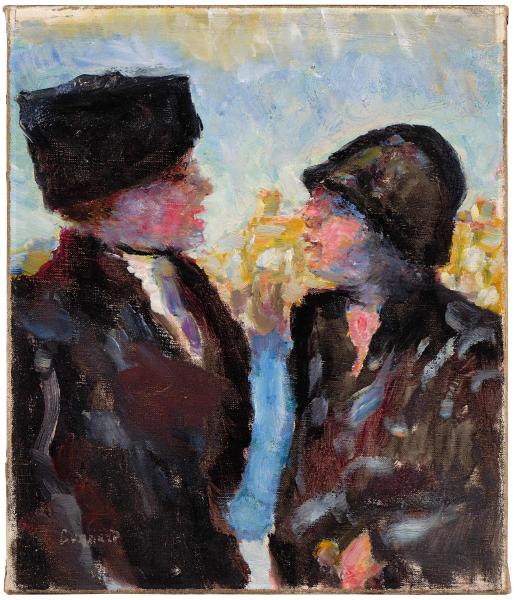La conversation, circa 1913
Oil on canvas, estate stamped lower left.
28 x 23 cm
Provenance :
Succession Bonnard
Pierre and Marie-Françoise Vernon Collection
Exhibitions :
Pierre Bonnard, Arthur Tooth & sons, London, June 17 - July 12, 1969, reproduced in the exhibition catalog under no. 1.
Pierre Bonnard: Observing Nature, National Gallery of Australia, March 7 - June 09, 2003 then Queensland Art Gallery, July 4 - September 28, 2003, reproduced in catalog no. 28. Matisse e Bonnard, Viva la pittura!, Rome, October 6, 2006-February 4, 2007. reproduced under no. 141.
Amitiés, Bonnard-Matisse, Fondation Marguerite & Aimé Maeght, Saint-Paul-de-Vence, June 29 - October 6, 2024.
Bibliography :
Jean and Henry Dauberville, Bonnard: catalog raisonné de l'oeuvre peint, vol. 4 (1940 - 1947), Bernheim-Jeune, Paris, 1974, no. 02036
THE INTIMATE CONVICTION OF THE SOUTH
To understand the Bonnard in love with the South, crocheting light and color into his palette, you first need to have seen the other Bonnard, the one of chilly winters and gray mornings.
You need to have known the "very Japanese Nabi", his meticulous layouts, superimposing points of view, his tight, daring framing, his exploration of flatness, with the Japanese print as source and model. Like Vuillard, Vuillard's friend delights in the intimacies he recreates. Dining rooms and bedrooms are conducive to revealing subtle atmospheres, rendered in contrasting hues, with an economy of palette that would later no longer characterize him.
Night-time entertainment venues, and the street itself, also became enclosed spaces for the artist through framing, enabling him to extract a fragment of intimacy, like a clear cut to the heart of passing life.
In 1904, he discovered the South, and nothing would ever be the same again. He wrote to his mother in a phrase that has remained famous throughout his life: "I was struck by the Thousand and One Nights. The sea, the yellow walls, the reflections as colorful as the lights...".
This is the dazzling, sensual, unrestrained greed of the palette. Landscapes exult, light spreads like an immense, tender, joyful wave. Bonnard has tasted paradise on earth. It was in Le Cannet that he would end his days, putting all his strength into his painting.
Marthe the muse, the woman. The one Bonnard always swore by, even though he was not always faithful to her. However, he gave her his final preference by marrying her after a long life together, forsaking for her the young, blond Renée, who would drown in her bathtub in sadness.
Marthe's shady, exclusive character and the constant precautions she took to protect her health were, for many, what kept Bonnard away from the outside world. She had little pleasure in socializing with other people, and jealously guarded the purr of a life for two that was never drowned out by a child's cry. However, she seems to have a genuine complicity with Suzanne, wife of Gaston Bernheim, Bonnard's regular dealer since 1906. A photograph shows the two of them together, with Bonnard, in the outfit they wear when they are portrayed here in bust form, deep in conversation. In the photo, their dogs frolic at their feet. Perhaps they understood each other...

